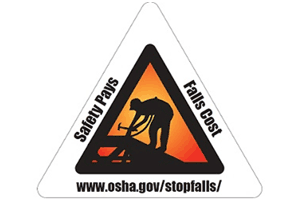Fixed Ladder Inspection Checklist
Below you will find a basic fixed ladder safety inspection checklist to help ensure safe roof access for all of your employees. This list is relevant to fixed vertical ladders with a climbing angle of 90 degrees. Where applicable the list has the portion of OSHA and ANSI referenced where the ladder safety item originates. For more information check out our roof access ladders.
RUNGS:
- The first rung is within 14" of the ground. (required by ANSI A14.3-2002)
- Ladder rungs are between 10" to 14" apart and are uniform distance apart throughout the ladder length. (required by OSHA 1910.23(b)(2))
- The ladder rung clear width between ladder side members is at least 16" wide (required by OSHA 1910.23(b)(4))
SIDE RAILS:
- On walk-thru or sidestep ladders, side rails extend 42" above the top of the access level and are flared for clearance of 24" to 30" (required by OSHA 1910.23(d)(4))
FIXED LADDER CLEARANCES:
- Any obstruction on the climbing side of a vertical ladder is at least 30" away from the centerline of the rung. This applies to roof hatches too. You can use a smaller hatch that allows less than 30" (but at least 24"), but you need to have deflector plates at the underside of the hatch opening. OSHA's example can be found here. (required by OSHA 1910.23(d)(13)(ii))
- A clear width of 15" to the right and left from the centerline of the ladder is required if the ladder does not have a cage. For example: if the ladder is 20" wide, there must be 5" of clearance to the right and 5" of clearance to the left beyond the ladder sides. (required by OSHA 1910.23(d)(13)(i))
- Any obstruction behind the ladder is at least 7" away from the centerline of the rungs. For example: if there is a 2" thick pipe running across the wall behind the ladder, the ladder will need to be 9" (7"+2") away from the wall. (required by OSHA 1910.23(d)(2)) Note: exception given for elevator pit ladders only down to 4.5" from 7".
- For through ladders, the distance from the centerline of the top rung to the step across is between 7" and 12". If an obstruction like a gutter or conduit causes the ladder to be further than 12" from the wall, you will need to have a step across platform at the top to bridge that gap (required by OSHA 1910.23(d)(12)(i))
- For side step ladders, the distance from the centerline of the rung to platform edge is not less than 15" or more than 20" to the platform edge. I.e., 20" wide ladder can only be 5" to 10" from the landing platform edge (required by OSHA 1910.23(d)(12)(ii))
PERSONAL FALL ARREST SYSTEMS
(For ladders installed OR MODIFIED after November 18th, 2018 - Note that after November 18th, 2036, this applies to all ladders, even ladders installed before November 18th, 2018.)
- If your floor to floor height is greater than 24', your fixed ladder is equipped with a personal fall arrest system. (OSHA 1910.28(b)(9)(i)(A)).
CAGES
(For ladders installed before November 19, 2018 (OSHA 1910.28(b)(9)(i)(A))
- If there is no cage, the floor to ladder step off height is 24' or under or a fall protection system such as a cable is in use. (OSHA 1910.29(b)(9)(i)(B))
- If there is a cage, it needs to extend 42" above the top of the landing unless going to a hatchway or manhole opening (required by OSHA 1910.27(d)(1)(iii))
- The bottom of the cage starts between 7' and 8' from the ground. (required by OSHA 1910.27(d)(1)(iv))
- The bottom of the ladder cage is flared at least 4". (OSHA 1910.27(d)(1)(iv))
- Clearance from the centerline of the ladder rung to the back of the cage is between 27" and 28", and the cage is at least 27" wide. (OSHA 1910.27(d)(1)(v))
- The vertical bars of the cage are no further than 40 degrees apart, giving a maximum spacing of (approx) 9.5" centerline to centerline. (required by OSHA 1910.27(d)(1)(v))
- For climbs over 24', the ladder MUST be retrofitted with a fall protection device before November 18th, 2036. Also, if a ladder over 24' is repaired/section is replaced, that section will need to have a fall protection device installed at that time, regardless of whether it is before November 18th of 2036 or not. (OSHA 1910.28(b)(9)(ii))
- Ensure cage does not interfere with personal fall arrest system's operation. (OSHA 1910.28(b)(9)(iv)
LANDING PLATFORMS
- Installed at intervals of no more than 150' (OSHA 1910.28(b)(9)(ii)(B)
- If there are landing platforms, they are at least 24" x 30" (required by OSHA 1910.27(d)(2)(ii))
- One rung of the ladder accessing the landing platform must be at the level of the the platform. (required by OSHA 1910.27(d)(2)(iii))
- Landing platform has toeboard and railing except at opening for safe ladder access (required by OSHA 1910.27(d)(2)(ii))
WALK THROUGH HANDRAILS
- If the ladder has a through exit, the ladder's walk-through handrails must extend 42" above parapets and landings (required by OSHA 1910.23(d)(4))
- The clearance between rails on the walk through handrails must be between 24" and 30". (required by OSHA 1910.23(d)(5))
Rev. 4/19



